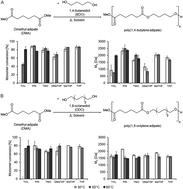Safer bio-based solvents to replace toluene and tetrahydrofuran for the biocatalyzed synthesis of polyesters†
Abstract
With increased awareness of environmental issues caused by traditional petrochemical processes, both academia and industry are making enormous efforts towards the development of sustainable practices using renewable biomass as a feedstock. In this work, the biocatalyzed synthesis of polyesters derived from renewable monomers was performed in safer, bio-derivable organic solvents. Candida antarctica lipase B (CaLB), an enzyme belonging to the Ser-hydrolase family (adsorbed on methacrylic resin, also known as Novozym 435) was tested for its performance in the synthesis of adipate- and furandicarboxylate-based polyesters. In addition, the traditional solvents toluene and tetrahydrofuran were compared with a series of green solvents, 2,2,5,5-tetramethyloxolane, 2-methyltetrahydrofuran, 2,5-dimethyltetrahydrofuran and pinacolone for the enzymatic polymerizations. We can conclude that the monomer conversions and molecular masses of the obtained polyesters in all the tested alternative solvents were suitable, and in some cases superior, with CaLB immobilized via physisorption on acrylic resin being the optimal biocatalyst for all reactions. Strikingly, it was found that for the majority of the new solvents, lower reaction temperatures gave comparable monomer conversions and polymers with similar molecular weights whilst pinacolone yielded better polymers with Mn > 2000 Da and conversions of over 80%.



 Please wait while we load your content...
Please wait while we load your content...